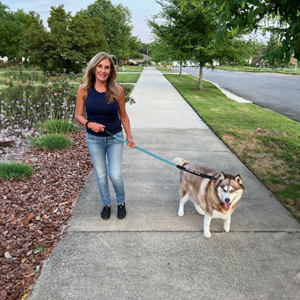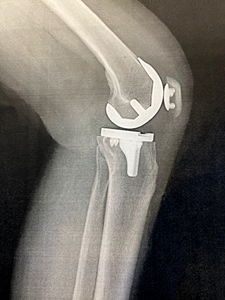06-28-2024
Robotics-Assisted Knee Replacement Relieves Pain, Improves Mobility
Find A Center
 Kim Slattery’s passion for running spans four decades.
Kim Slattery’s passion for running spans four decades.
The 66-year-old Gainesville, Florida, woman enjoyed racing in 5ks and half marathons across the city.
“I just love to run,” she said. “I put on my headset and get in my own little world.”
Over the past decade, Slattery had dealt with slight tendonitis in her knees, but the intense pain in her left knee during the winter of 2023 halted her activities.
“It got to the point where I could hardly walk,” she said. “I was limping. I’d get done running, and my knee would hurt so bad.”
Tests Reveal Arthritis, Meniscus Tear
To discuss treatment options, Slattery consulted Tristan A. Altbuch, MD, an orthopedic surgeon at The Orthopaedic Institute in Gainesville.
Her X-rays displayed early signs of arthritis, and an MRI detected a complicated meniscus tear in Slattery’s knee.
“Instead of going right to a knee replacement, we went and cleaned up the tearing in the cartilage in her knee,” Dr. Altbuch said. “I think from her X-rays and from her functional level, and the amount of pain that she was having, a knee replacement at that time wasn’t warranted.”
Over the next six months, Slattery’s arthritis worsened in her left knee joint. Constant pain made carrying a laundry basket, shopping and even walking difficult. She relied on anti-inflammatory pain medications to help her sleep.
“[Arthritis] really didn’t bother me until I tore my meniscus,” Slattery said. “I could barely walk. It hurt so bad.”
Often referred to as “wear and tear” arthritis, osteoarthritis develops in the hips, knees and hands most frequently. Osteoarthritis causes the deterioration of cartilage in joints, resulting in bones rubbing against each other, leading to pain and limited movement.
“Arthritis is a little bit like a vice that slowly tightens on lifestyle,” Dr. Altbuch said. “Her knee joint spaces continued to narrow and compress against each other. That led to her having more pain, significant enough to interfere with activities and daily living.”
Patient Chooses Robotics-Assisted Surgery
 Eight months after her meniscus surgery, Slattery opted for a robotics-assisted total knee replacement with Dr. Altbuch on Nov. 16, 2023, at The Orthopaedic Surgery Center of Gainesville.
Eight months after her meniscus surgery, Slattery opted for a robotics-assisted total knee replacement with Dr. Altbuch on Nov. 16, 2023, at The Orthopaedic Surgery Center of Gainesville.
“Once I had that [cartilage] removed, it progressed pretty fast to bone-on-bone,” Slattery said. “I knew I was looking at a total knee eventually, but I didn’t think it would be that fast.”
A robotics platform for knee replacement uses a CT scan of a patient’s joint to customize a surgical plan. During surgery, Dr. Altbuch guided a robotic arm to remove damaged arthritic bone and cartilage from Slattery’s knee. Then, he replaced her knee with prosthetic components called implants.
“I had surgery at 7:30 a.m. I was home by noon,” she said. “I wanted to go home. There’s no place like home, you know. My husband was here, and my kids would come to see me.”
Days after surgery, Slattery started physical therapy.
“You can’t let your knee stiffen, so you’ve got to work it. Therapy is tough, and I went twice a week,” she said. “I saw my X-ray, and my X-ray looked perfect. I just knew it was all up to me now to put in the work to get it going again.”
Patients may experience less swelling and faster recovery with a robotics-assisted procedure but still encounter post-operative pain.
“Knee replacement surgeries are some of the most challenging surgeries that patients will go through,” Dr. Altbuch said. “The hardest thing for patients is you have to move it when it hurts the most. It does require a great deal of commitment from the patients to push through that first couple of weeks, which are the toughest.”
After three months of hard work, Slattery completed her physical therapy and resumed regular activities, including walking, standing and climbing stairs.
Now six months after surgery, she rides her bike, plays golf and walks her Siberian huskies, Madigan and Mingo, with her husband.
“The only thing I can’t do — I cannot run. That’s a bummer for me, because that was a big part of my life,” she said. “I get by without running. I’ve got too many other things I can still do, so I’m good.
“The key to me was just living pain free again.”
Surgery Centers Benefit Patients
As a staff assistant/medical technician at The Orthopaedic Institute for 32 years, Slattery helped patients who underwent total joint replacement surgery. Now as a patient, Slattery said she benefitted from robotic technology and recovery at home.
“We did a lot of total knees and total hips. They didn’t have the technology that they have now. Our patients used to be admitted two days before surgery, and then they’d be in the hospital five days after their surgery,” she said. “Times have changed. It’s just wonderful.”
Ambulatory surgery centers offer patients a more comfortable environment at a lower expense with convenient parking, shorter wait times and a decreased ratio of patients to nurses. Patients are sent home on the same day as the procedure to recuperate.

A patient’s age, existing medical conditions and the support they receive at home help doctors to determine whether he or she is suitable for outpatient surgery.
Don’t Delay Your Treatment
May is Arthritis Awareness Month. Arthritis is the leading cause of long-term disability in the U.S., impacting more than 53 million adults.
“As our population ages and the activity levels maintain at a high level for people, you start to see wear and tear in the joints,” Dr. Altbuch said.
If you have arthritis and are experiencing chronic joint pain, treatment plans may include medication, physical therapy or knee replacement to reduce your pain and increase your range of motion.
“I would definitely recommend a total joint, if they’re having the symptoms I had,” Slattery said. “Why wait around when you’ve got a solution to fix it?”
If chronic pain is affecting your daily activities, it’s important to seek treatment before symptoms worsen. Find one of our orthopedic centers near you to request an appointment for an evaluation.
This article is designed for educational purposes only. The information provided should not be used for diagnosing or treating a health concern or disease. It is not a substitute for professional care. If you have or suspect you may have a health concern, you should consult your healthcare provider.
